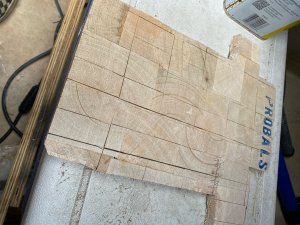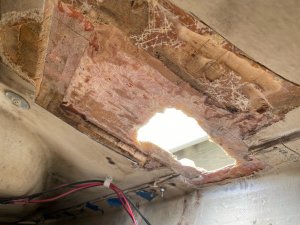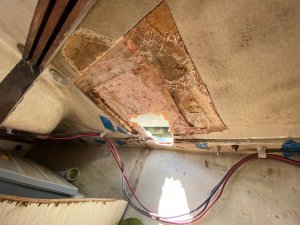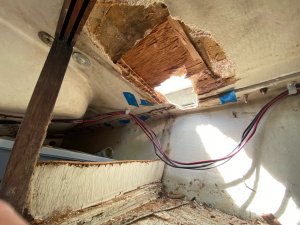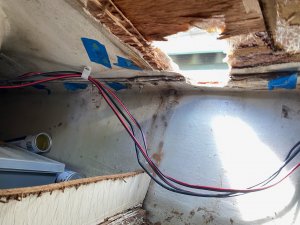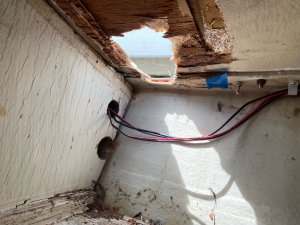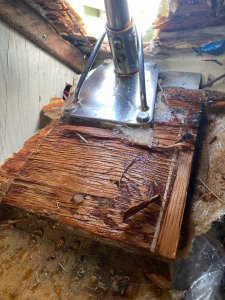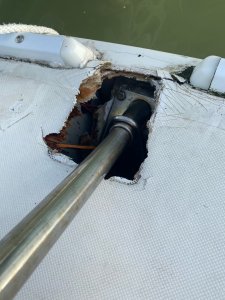Haven't sailed her in a couple months. Wife and I went to check on her a week ago (Friend's house fixed dock) and the port side stanchion, second from aft had been smashed in. Maybe low tide and lots of wind... not sure. Problem is that of course it sits just forward of the cabinet and also encompasses the hull/deck joint. Super horrible place for a 6'2" guy to try to do work. I managed to clean everything out (also noticed it was plywood and then balsa... made me think someone had rebedded this before... Because the balsa core stops close to the hull/deck joint, I planned to take the balsa all the way to the hull and just slop on a thick epoxy with some fiberglass on top and once semi set, do the deck. Once that hardens, fiberglass the hell out of the bottom and eventually replace the side of the cabinet as it may help support the deck a bit. Any other ideas from you guys? I'm kind of wavering on using plywood again or just the balsa... I've already cut the balsa but it's going to be weird where the hull/deck joint is and is skinny. I'm good at fiberglassing and that normally makes up for a lot, but just want to hear your thoughts. Probably going to finish tomorrow. Many Thanks in advance. -Christian FYI- The pictures are in reverse order.
Navigation
Install the app
How to install the app on iOS
Follow along with the video below to see how to install our site as a web app on your home screen.

Note: This feature currently requires accessing the site using the built-in Safari browser.
More options
You are using an out of date browser. It may not display this or other websites correctly.
You should upgrade or use an alternative browser.
You should upgrade or use an alternative browser.
Stanchion Collapsed Through the Deck - Am I fixing it Correctly?
- Thread starter Pingpro
- Start date
I'd give you my two cents if you're not done, but you said you'd probably finish on Sunday. I think you should take your time so it's done well and you don't regret it later. For me it would be a multi-step process that would take several days.
Let me know if you want my thoughts about how I'd do it.
Vince
Let me know if you want my thoughts about how I'd do it.
Vince
Thanks Vince, I came to the same conclusion as you just outlined. It's going to take several days. I have the balsa up, as well as a couple strips of glass at the hull/deck joint. Next step will be making some "Peanut Butter" resin and leveling out the difference between the balsa and the existing areas. I'll let that set and then do the rest of the glass on the bottom side, let that set and then sand and do the topside. Of course if you have some ideas, let me know. I probably won't get to work on it until Thursday.
I'm not exactly sure what path you're following, but I have my thoughts upon seeing your photos, so here's my 2 cents:
I think the difficult parts will be 1) filling the 'hole'. I've replaced balsa core from above and from below, either way having something to build against: an existing layer of deck (either top or bottom). I've only fixed holes all the way through that were pretty small. Maybe an inch or so in diameter. You'll need something to approximate the curve of the deck, upon which you can start laminating to re-build the deck. 2) Working in the tight area near the hull, and between the two toe-rails. It would be best if you could remove them, but they might not come off without destroying them.
That shelf above the berth comes out without too much trouble. I rebuilt mine as they were rotted from water leaking at the hull/deck joint. Re-caulking that was the single most satisfying repair I did over the years.
Despite the good pictures, I'm not sure... but I think you've removed balsa core for some distance beyond the hole. Good.
Of course you'll use your good judgement and do whatever you think, but this is how I'd go about it:
Vince
I think the difficult parts will be 1) filling the 'hole'. I've replaced balsa core from above and from below, either way having something to build against: an existing layer of deck (either top or bottom). I've only fixed holes all the way through that were pretty small. Maybe an inch or so in diameter. You'll need something to approximate the curve of the deck, upon which you can start laminating to re-build the deck. 2) Working in the tight area near the hull, and between the two toe-rails. It would be best if you could remove them, but they might not come off without destroying them.
That shelf above the berth comes out without too much trouble. I rebuilt mine as they were rotted from water leaking at the hull/deck joint. Re-caulking that was the single most satisfying repair I did over the years.
Despite the good pictures, I'm not sure... but I think you've removed balsa core for some distance beyond the hole. Good.
Of course you'll use your good judgement and do whatever you think, but this is how I'd go about it:
- Square-up the hole in the deck, but probably with rounded corners.
- Bevel the edges of the hole on the exterior deck surface, so that you have a sloped surface upon which to bond new layers of glass when you laminate the new deck. About an inch, I think. I think the laminate is 1/8 in. So that's an 8:1 bevel.
- Cut a piece of 1/4 in. plywood, oversize compared to the hole by, say, 1.5 inches all around. So, if your hole is 6"x6", your plywood is 9"x9".
- The old balsa is removed with a powerful sander / grinder right down to the fiberglass laminate. Then bond the plywood to the underside of the deck to cover the hole. Use thickened epoxy on the surfaces where the ply is in contact with the underside of the deck. I think fumed / colloidal silica or West's "adhesive" filler. Preferably not microballoons (less strong), but maybe they're ok. Use a stick or sticks propped from underneath to flex the plywood so it matches the curve of the deck.
- Once it sets-up, you now have something to bond layers of glass or core to. You can use plywood of whatever thickness is needed (maybe just another layer of 1/4 in.) for the area where the stanchion mounts. Any additional areas around it where you've removed balsa, you can fill with the balsa you have (I think I'm seeing that you have balsa). My (early, 1978) boat had balsa under the stanchions, but maybe yours had plywood.
- To bond core in place, I've first trowled thickened epoxy into the cavity with a notched spreader and pushed the piece of core up into the deck. Then used plastic sheet against the core from below followed by foam padding (from a rug or something), a plywood board, and finally the prop-sticks to hold it all in place while the epoxy cures. Foam is just to distribute pressure across the core as it's held.
- Lay up your top and bottom deck laminate with 3 or 4 layers of glass cloth / mat on both the upper surface and the underside. On the underside, thin plastic sheeting seems to somehow help with surface tension to keep it in place while it cures. Or use the plastic sheet / foam/ prop. You may want to apply more epoxy, or epoxy with a filler on the exterior surface when it's mostly cured, to fill the weave. If something has had a full overnight cure, don't forget to wash off amine blush and abrade things before the next layer. Best to be all ready and do all the laminating in one long day. Some heat can help speed things along.
- You'll probably need to do some fairing on top, and then gel-coat.
- When you initially glue-in a piece of plywood from below maybe it goes almost all the way to the hull, but once it's bonded you can bevel it back somewhat with a grinder / sander.
Vince
BTW... for those wanting to do these kinds of repairs but are new at it, West System has great documentation about how to do it:
Basic techniques start on pg. 21 of this one: https://www.westsystem.com/wp-content/uploads/User-Manual-2015.pdf
Fiberglass boat repair manual: https://www.westsystem.com/wp-content/uploads/Fiberglass-Manual-2015.pdf Very good; all the details!
-V
Basic techniques start on pg. 21 of this one: https://www.westsystem.com/wp-content/uploads/User-Manual-2015.pdf
Fiberglass boat repair manual: https://www.westsystem.com/wp-content/uploads/Fiberglass-Manual-2015.pdf Very good; all the details!
-V
